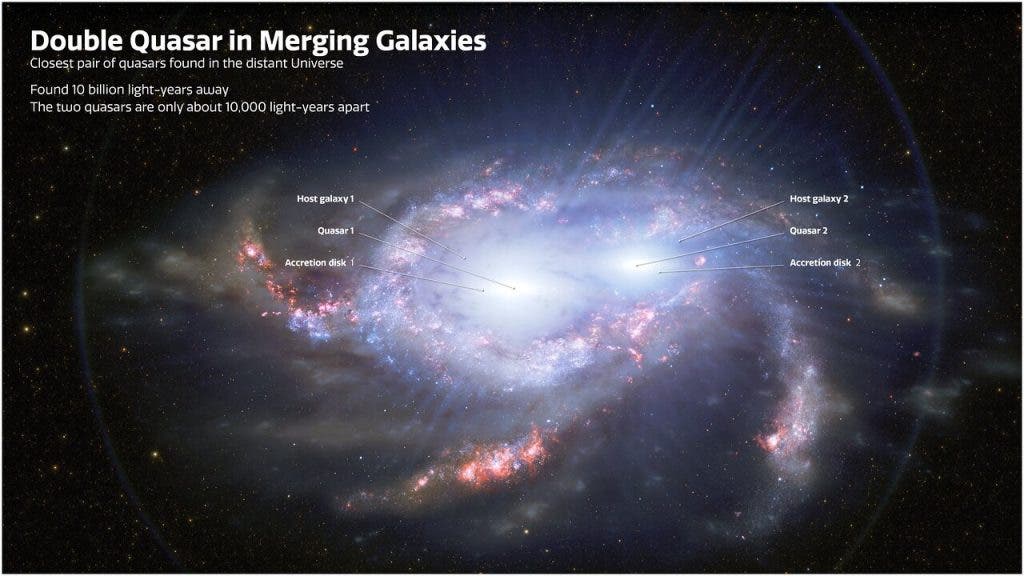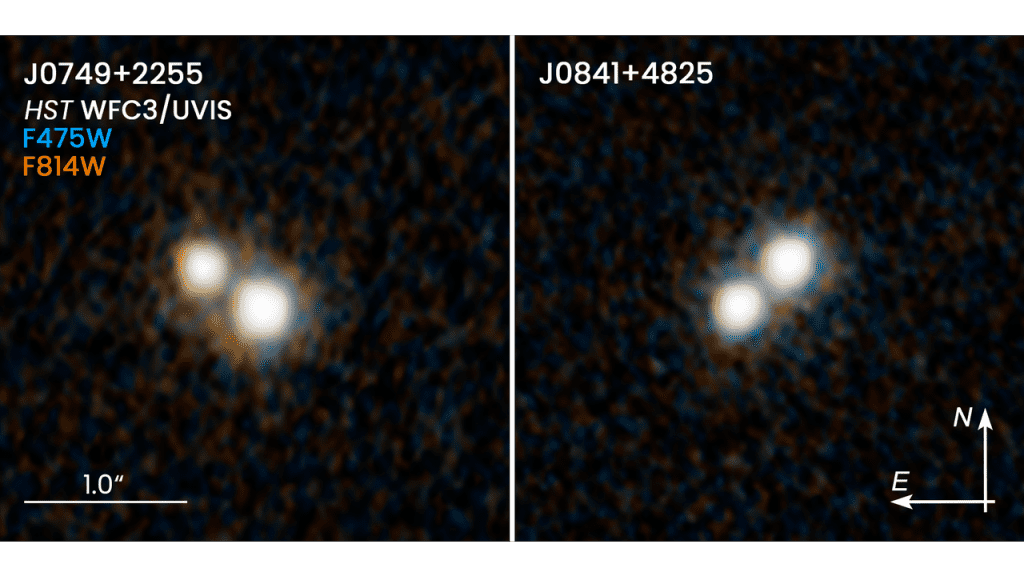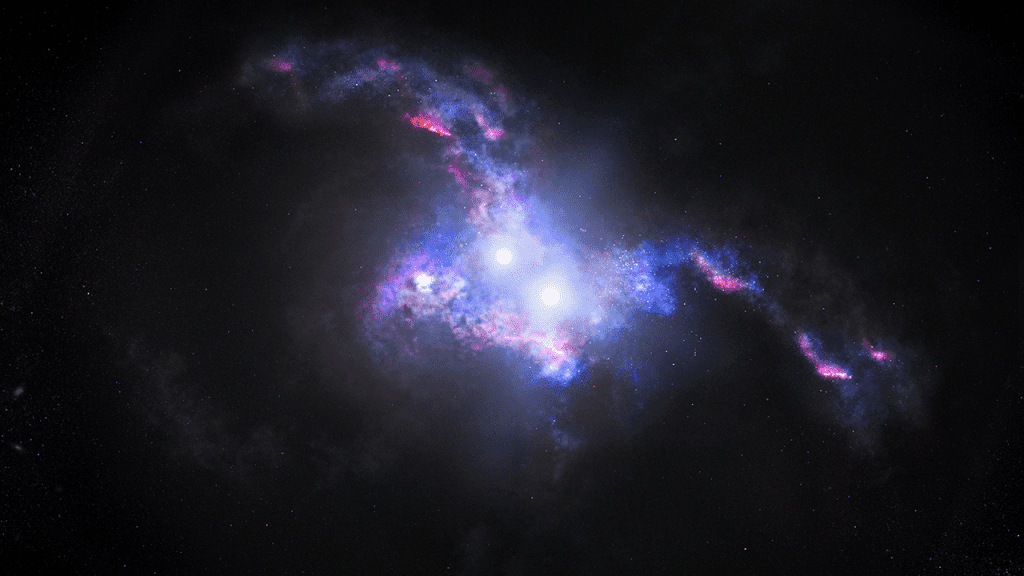Astronomers have observed two pairs of quasars in the distant Universe, closer together than any previously observed examples of similar pairings. The team followed the discovery–made with the Hubble Space Telescope and Gaia spacecraft–with spectroscopic observations made by the Gemini North Telescope.
The discovery is significant as it points towards the possible existence of supermassive black hole (SMBH) pairs. As the quasar pairs exist in merging galaxies, the finding also grants researchers an insight into how such events could have proceeded in the early Universe.

It is the relatively close proximity between the quasars in the two pairings of just 10-thousand light-years that suggests to the astronomers that they belong to merging galaxies.
“We estimate that in the distant Universe, for every one thousand quasars, there is one double quasar,” says Yue Shen, an astronomer at the University of Illinois. “So finding these double quasars is like finding a needle in a haystack.”
Shen is the lead author of a paper published in the latest edition of the journal Nature Astronomy.
Quasars sit at the centre of galaxies in an area known as the active galactic nuclei (AGN) blasting out powerful jets of radiation. They are powered by SMBHs devouring material like gas and dust that surrounds them.
Quasars are so powerful that they profoundly affect the evolution of galaxies around them. This means that studying them is also a great way of learning how galaxies come together.
These particular quasars are 10-billion light-years from Earth meaning they existed just four billion years after the Big Bang. Double quasars are, in of themselves, rare, especially at such great distances. But, what makes these pairs particularly interesting is the fact they point to even rarer, hitherto undiscovered, SMBH binaries.

“This truly is the first sample of dual quasars at the peak epoch of galaxy formation that we can use to probe ideas about how supermassive black holes come together to eventually form a binary,” says Nadia Zakamska, Johns Hopkins University, part of the team that made the discovery.
Supermassive Implications
The team’s discovery will excite scientists currently involved in the search for SMBH binaries. Current theories suggest that as monstrous as they are these black holes, which are believed to lurk at the centre of most galaxies, do not always exist in isolation.
Alessandra De Rosa is a research astrophysicist at the National Institute of Astrophysics, Italy, and the author of a recent review paper which summarizes what we know thus far about SMBH pairs.
“Searching for high z dual Active Galactic Nuclei at such small separations is a fundamental piece of information to understand how SMBHs could form and grow and to probe what we know about galaxy formation and evolution,” DeRosa, who was not involved in the team’s study, tells ZME Science. “Moreover, these systems are the most direct precursors of binary SMBHs which are amongst the loudest emitters of gravitational waves in the low-frequency ranges.”
DeRosa continues by explaining that the search for these objects at such great distances is extremely challenging due to instrument limitations that prevent them from being individually distinguished.
Until now it has been believed that these pairings would find the black holes in such close proximity that they could only be distinguished by the gravitational waves launched by their eventual merger.
This new research could offer another way to at least study how such SMBH pairings come together and form binaries.
Tracking Down Quasar Pairs
As DeRosa points out, tracking down these quasar pairs at a distance of around 10-billion years was no easy task. In order to do this, the astronomers employed a novel new method that unites data from several space-based and ground-based telescopes.
It takes an extremely powerful telescope to view objects at such distances limiting the team’s choice to the Gemini North telescope in Hawai’i, and the Hubble Space Telescope. Because observing time on these telescopes is extremely limited, sweeping the entire sky for quasar pairs was out of the question.

To work around this, the team selected 15 quasars from the 3D map created from data collected by the Sloan Digital Sky Survey (SDSS). Observations from the Gaia spacecraft were then used to narrow these 15 quasars to candidates that could actually be pairs.
The last step of the process was using Hubble to get a better look at these suspects. In this way, the team was able to confirm that two of the objects they selected were indeed quasar pairs.
Further investigation with Gemini North and its Gemini Multi-Object Spectrograph (GMOS) instrument allowed the astronomers to resolve the quasars’ individual spectra. Locked within this light signature is information regarding the distance from Earth and the quasars’ compositions.
“The Gemini observations were critically important to our success because they provided spatially resolved spectra to yield redshifts and spectroscopic confirmations simultaneously for both quasars in a double,” says Yu-Ching Chen, part of the team and a graduate student at the University of Illinois. “This method unambiguously rejected interlopers due to chance superpositions such as from unassociated star-quasar systems.”
The Next Steps for Studying Quasar Pairs
Whilst the team is extremely confident that they have discovered quasar pairs in merging galaxies, there does remain the slight chance that they have actually captured a double image of a single quasar.
This kind of doppelganger illusion can be caused by strong gravitational lensing, the bending of light from a distant source when an object of great mass passes between it and our line of sight.
In extreme cases, this lensing can cause objects to appear at multiple points in the sky due to light being forced to take different paths across the Universe. Striking examples are so-called Einstein crosses and rings when single light sources appear at numerous points in a geometrical pattern.

The researchers believe that this can be discounted in the case of their research as the light from the distant quasars did not pass an intersecting foreground galaxy.
The next step for the researchers is the research for more quasar pairs, hopefully leading to the development of a census of such duos in the early universe.
“This proof of concept really demonstrates that our targeted search for dual quasars is very efficient,” Hsiang-Chih Hwang, the principal investigator of the Hubble observations and a graduate at John Hopkins University, concludes. “It opens a new direction where we can accumulate a lot more interesting systems to follow up, which astronomers weren’t able to do with previous techniques or datasets.”


